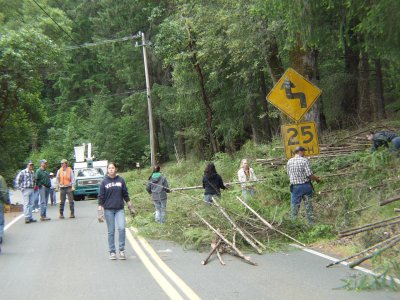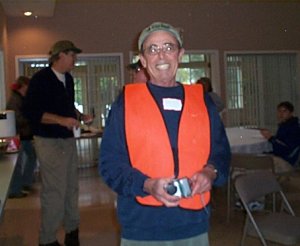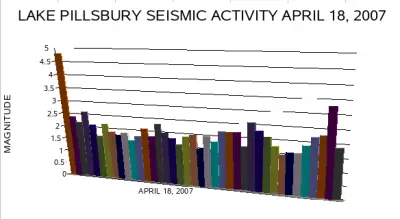- Elizabeth Larson
- Posted On
Black Forest effort brings out community spirit

THE BLACK FOREST – Several dozen volunteers came out on Saturday morning to help clear cut brush and make the Black Forest safer before the coming fire season.
The Earth Day project at the Black Forest, which Buckingham resident Joel Witherell led the charge in organizing, resulted in an estimated 25 cords of fire hazard material being cleared and chipped, Witherell estimated Sunday.
Cal Fire (formerly known as CDF) crews had begun cutting the brush and fallen trees early last week in preparation for the weekend volunteer effort. Carle High School students worked during the week to drag the cut materials to the roadside. Volunteers then put the materials through the chippers, which Witherell said worked a total of 10 hours over both Friday and Saturday.
Witherell estimated it will take a 15-person Cal Fire crew to finish the chipping of materials still located along a portion of Soda Bay Road.
He reported that Cal Fire Captain Todd Nelson said the work has helped created "defensible space needed by fire agencies," and that the work that the volunteers did “gives fire personnel a chance to extinguish a fire before it gets out of hand.”
“I think we had nine chain saws going all morning,” Witherell said of Saturday morning's effort.
About 130 different people worked throughout the week on the project, he added. County staff assisted in providing signs and permits for road closure, Jeff Rein of the administrative office pulled together the money to pay for the chipping, Kelseyville Fire's Howard Strickler and Brian Burnham kept an ambulance on hand in case of injuries to volunteers.
Carle High School Principal Bill MacDougall and his students worked on the project for two days, said Witherell. Teachers Tami Kramer of Kelseyville High and Oscar Dominguez of Clear Lake High also brought students Saturday. Even the Brownies came to help work – and play – in the forest.
Others who were important in the effort included Adam Nichols of Nichols Tree Service, Jack Pauling of Paulin Family Tree Service, and Dave Mostin and his crew, which worked for two days. Bob Braito worked on Saturday clearing brush off Soda Bay Road, said Witherell.
The county's deputy redevelopment director, Eric Seely, spent hours in the forest with a 42-inch chain saw, cutting up dead trees. County Administrative Officer Kelly Cox was a steady force during the day, working tirelessly to load brush into the chippers.
Witherell thanked Karen MacDougall and Phyllis Clement for working at the registration table; Helen Finch and Victoria Brandon; Steve Devoto, who worked at a chipper Saturday and helped handle the original escrow papers that saved the forest from logging several years ago; Neil Towne, Sandy Moura and others who did trash pickup for miles; the Big Valley Lion Club members who directed parking; Don Fehr, another Big Valley Lion, who provided 15 pizzas for the celebration lunch; Wayne Scott; Jodelle Scott; Kevin, Karen and Frank Bradley; and Kris Perkins.
He also recognized Julie Berry of the Buckingham Homes Association, who he called an “amazing support” during the six months of planning the event, as well as working at the registration table during the morning and organizing the lunch for volunteers at the association's clubhouse.
Witherell, who has spent months organizing the event, had the support of his entire family in the project, including wife Virginia, and his sons and daughters.
On Sunday, Witherell said the difference in the forest was strikingly apparent in the wake of so much brush and debris being cleared out.
“The deer are grazing in the background and have quickly recovered from the chain saw activity yesterday,” he said. “The cars are slowing down and looking into the forest. The huge rocks with bright green moss shimmering in the sun. One family that worked yesterday said they wanted to bring their Girl Scout Troop back and have a picnic in the Forest. They had no idea what was behind the brush along the road.”
He added, “There was an amazing community spirit in Lake County for the Earth Day-Black Forest project.”
E-mail Elizabeth Larson at This email address is being protected from spambots. You need JavaScript enabled to view it..

{mos_sb_discuss:2}











